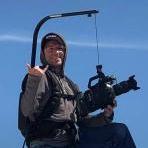-
Posts
160 -
Joined
-
Last visited
Reputation Activity
-
 joema got a reaction from The Chris in Thoughts on a7rII/a7s replacement for stills and video?
joema got a reaction from The Chris in Thoughts on a7rII/a7s replacement for stills and video?
What exactly is the problem? we shoot lots of 4K content with the GH4, A7RII, DVX200 and various other cameras. In Super35 mode I don't have any issues with the A7RII video image quality. The new Sony 24-70 f/2.8 G-Master lens is very nice, although I use the 28-135 f/4 cinema lens a lot due to the motorized zoom. The camera needs several refinements, including fast switching in/out of Super35 mode, about 3x the writing rate to SD (needed for raw stills), etc. but it's pretty good as is. The ability to use Canon L lenses on the Sony E-mount cameras via Metabones adapters is handy.
-
 joema got a reaction from IronFilm in Drones. Which one?
joema got a reaction from IronFilm in Drones. Which one?
That is a good but fairly expensive package. If you have no experience flying a drone I strongly suggest you get a DJI Phantom 3 Standard or 4K to practice with. those are $500-$650. Don't practice from a dead start with the X5R.
My documentary team has an FAA licenced rotorcraft pilot to fly our fleet of three Phantom 3 Pros, although we may upgrade to the Inspire/X5R. It is not legally required but he's a helicopter pilot and has lots of drone experience. He is constantly reading, studying and practicing to optimize our chances when we get on site. He has a large tacklebox of repair parts and tools. Despite that experience, he has crashed several drones on various shooting sites. Most of those were not disastrous but several of them could have been.
-
 joema got a reaction from jgharding in Transcoding AVCHD to ProRes?
joema got a reaction from jgharding in Transcoding AVCHD to ProRes?
You have CS6 and I think Mercury Playback was only introduced on CS5. It probably got a lot more use via nVidia/CUDA than OpenCL/AMD, so maybe that accounts for the reliability issues you saw. Re ProRes, this helps performance due to eliminating the need for H264 decoding. Long-GOP encode/decode like H264 cannot be greatly accelerated by normal GPU methods so using Mercury hardware playback doesn't help that per se. However Mercury hardware playback makes a huge difference on effects. Since virtually all editing requires effects the net result is GPU acceleration makes a big improvement even though it doesn't accelerate encode/decode by itself.
ClipWrap can either rewrap AVCHD which does not transcode but is faster to convert, or it can transcode which is slower to convert but will run faster on the editor. In your situation I would suggest transcoding. The tradeoff is ProRes takes about 8x the space of AVCHD and also requires more I/O for that lower-density data. However it greatly lowers the CPU consumption of editing and improves responsiveness.
In general I would suggest moving from CS6 to some other editor, whether that is Premiere CC, FCPX, or Resolve. CS6 is really old, is not being maintained, and you will get better performance, reliability and features on any of those other editors.
-
 joema got a reaction from Jonesy Jones in Drones. Which one?
joema got a reaction from Jonesy Jones in Drones. Which one?
The 4K aspect is a good idea. While the importance of 4K is often over-stated, for aerial footage it makes a big difference. This might be due to the detailed nature of foliage and the wide-angle nature of the shots. Or maybe the lower-end 1080p drones just weren't delivering nearly that, making "4K" look disproportionately better (even when downscaled to 1080p).
Even flying a lower-end drone like a DJI Phantom safely and effectively (from a cinematographic standpoint) requires a considerable amount of skill. All the time you take studying that, practicing, maintaining it, etc, is subtracted from your other pre-production time. For intermittent or infrequent needs I would tend to suggest just hiring one. If you want to develop a more self-sufficient capability, be prepared for the investment in study and time. Without considerable experience it is easy to crash an expensive drone.
Also inquire locally about what your regulatory, registration and enforcement situation is. There are a lot of issues about "geofencing", temporary flight restrictions (TFRs), etc.
-
 joema got a reaction from User in Transcoding AVCHD to ProRes?
joema got a reaction from User in Transcoding AVCHD to ProRes?
You have CS6 and I think Mercury Playback was only introduced on CS5. It probably got a lot more use via nVidia/CUDA than OpenCL/AMD, so maybe that accounts for the reliability issues you saw. Re ProRes, this helps performance due to eliminating the need for H264 decoding. Long-GOP encode/decode like H264 cannot be greatly accelerated by normal GPU methods so using Mercury hardware playback doesn't help that per se. However Mercury hardware playback makes a huge difference on effects. Since virtually all editing requires effects the net result is GPU acceleration makes a big improvement even though it doesn't accelerate encode/decode by itself.
ClipWrap can either rewrap AVCHD which does not transcode but is faster to convert, or it can transcode which is slower to convert but will run faster on the editor. In your situation I would suggest transcoding. The tradeoff is ProRes takes about 8x the space of AVCHD and also requires more I/O for that lower-density data. However it greatly lowers the CPU consumption of editing and improves responsiveness.
In general I would suggest moving from CS6 to some other editor, whether that is Premiere CC, FCPX, or Resolve. CS6 is really old, is not being maintained, and you will get better performance, reliability and features on any of those other editors.
-
 joema got a reaction from Mat Mayer in 2013 MacBook Pro - OSX 10.8.5 - Premiere Pro 8.2.0 - Software Update Before I Continue Editing?
joema got a reaction from Mat Mayer in 2013 MacBook Pro - OSX 10.8.5 - Premiere Pro 8.2.0 - Software Update Before I Continue Editing?
This free image resizer tool works great on Windows: https://imageresizer.codeplex.com/
-
 joema got a reaction from iamoui in Boost Performance for 4K editing on a Macbook Pro Mid 2012?
joema got a reaction from iamoui in Boost Performance for 4K editing on a Macbook Pro Mid 2012?
4K can be challenging to edit on even higher end machines. Since FCPX has seamless, built-in proxy support, your best approach is transcode to proxy on either import or afterward. This will yield a major editing speed improvement and doesn't cost anything. Procedure:
- Select clips in Event Browser
- Right-click, select "transcode media", then pick "Create proxy media"
- In upper-right corner of viewer, click drop down triangle and select "Proxy". Do not select "optimized", since that will take up too much space in your specific situation.
- Before final export to a file, change viewer back to "optimized/original", else output will be in proxy resolution
In most cases editing H264 content (even 4K) is not extremely I/O bound due to the compressed nature. It is generally CPU bound and effects often use the GPU. However editing itself, rendering the timeline (minus effects) and exporting (ie encoding) to a file are typically CPU bound operations. So you want good I/O performance but if you are already bottlenecked on the CPU then infinitely fast I/O won't help. Using proxy media greatly reduces the CPU burden.
That said, it is good practice to have your media on a different drive than your boot drive. The HGST Touro S 7200 rpm USB 3 drive is quite good for a bus-powered drive but it's not equal to an AC-powered 3.5" external drive. You could move your media to the Touro drive and see if this helps. The 2012 MacBook Pros have USB 3.0 so at least you don't have the problem caused by slow USB 2.0 ports.
-
 joema got a reaction from exomonkeyman in Thoughts on a lightweight run & gun DSLR RIGS
joema got a reaction from exomonkeyman in Thoughts on a lightweight run & gun DSLR RIGS
This is a good post. Your issues are similar to my field documentary group. We have tried many different camera types, various rigs etc. I loved my Canon 5D Mark III and Zacuto EVF Pro, but it was too slow to assemble and too fragile. As you well described, in fast-paced field environment, just 3-4 extra minutes is a long time. Then every time we changed sites it (a) Had to be torn down and packed, or (b) Balanced on a car seat or get somebody to hold it.
I now use an A7RII, Zacuto Marauder mini-rig, and Rode VideoMic Pro on the hot shoe: http://store.zacuto.com/marauder/ I can unpack it and be shooting in about 60 sec. We also use the Panasonic AG-DVX200, usually on a monopod. It is likewise very fast to set up: http://pro-av.panasonic.net/en/dvx4k/
For really fast run-and-gun, we just accept on-camera shotguns. If we have a few more seconds (e.g, a 30 sec stand-up interview) we use a clip-on Bluetooth wireless mic which is faster than our Sennheiser G3 lavs. The BT mic is available from Canon as the WM-V1: http://amzn.com/B004JNXDH6 or Sony as the ECMAW4: http://amzn.com/B00JWU6WWO
If we have more time we'll use the Sennheiser lavs, or boom-mounted Rode NTG-2/3, etc. However I generally don't like boom-mounted shotguns on fast-paced field shoots as they require a separate trained operator, it's more stuff to set up, and another thing sticking in the subject's face which inhibits their spontaneity.
-
 joema got a reaction from Hitfabryk in Canon 5dm3, thoughts
joema got a reaction from Hitfabryk in Canon 5dm3, thoughts
I have put 90,000 shots on my 5D3 plus many hours of documentary video. It is a great camera. I also have an A7RII and my group uses the GH4 and AG-DVX200 and we intercut all those.
I formerly used the Zacuto Z-Finder on the 5D3 and that was OK, but the Zacuto EVF Pro really transformed it. That's because it has built-in focus and peaking aids, plus on a hot-shoe mount the big eye cup provides a 3rd contact point which helps stabilize the camera. The downside is you must deal with a fragile HDMI cable, and if supported by a brace that adds complexity.
The Canon L lenses are great and I've hand held many interviews with the 70-200 F/2.8 IS II on the 5D3.
Of course there is no continuous AF in video mode which is why the EVF Pro helps so much. Magic Lantern is available for the 5D3 which has lots of video capability like peaking, zebras, etc: http://www.magiclantern.fm/ However I haven't used that since we are now transitioned to the 4k cameras. But with a good lens the 1080p from the 5D3 is excellent quality, and it has great low-light ability. When rolling video, the rear control dial becomes touch sensitive so you can adjust volume and other shooting parameters while shooting.
The 1080p output of the 5D3 is slightly soft but it's very good on aliasing and moire. You can recover the sharpness in post, whereas aliasing and moire are harder to fix in post.
I recommend you verify the shutter actuation count before buying it. Unfortunately ExifInfo and other tools won't provide this from a file but the camera must be connected via USB to a computer and run a utility like EOSInfo: http://www.khalids.com/downloads/SOFTWARE/Canon/
I have tested both IPB and All-I codecs, and I don't see much difference so I usually used IPB which makes smaller files.
For H264 video the card speed doesn't matter much but for bursts of raw stills the CF card interface is much faster than SD. I usually use only CF and the SD is for contingency only. Shooting to both cards simultaneously will slow it down to the speed of the slowest card (SD) so I only use CF most of the time, generally Lexar 1000x.
-
 joema got a reaction from Pitri in Camera for Glidecam-work (without Aliasing/Moire)?
joema got a reaction from Pitri in Camera for Glidecam-work (without Aliasing/Moire)?
My team uses various cameras on the big GlideCam X10 vest. There are pros and cons to each, but we recently got a little DJI Osmo X3, which works very well, including 4K. I've seen some complaints about image quality but IMO it looks pretty good. After more evaluation we might get the m-4/3 X5, which is about $2,500 for the entire kit: http://store.dji.com/product/osmo?gclid=Cj0KEQiA_fy0BRCwiLaQ5-iFgpwBEiQA884sOWChvTEJP_NXFyi9eehMdcvgfrgVbR0hDlofzxnQlQEaArXK8P8HAQ
Here is some material from the X5 (not mine, I just found it): https://www.youtube.com/watch?v=FVV9sjmJxmg
Low-light test shot with DJI Osmo X5: https://www.youtube.com/watch?v=Ot7RjZpoR0M
-
 joema got a reaction from sandro in how to proxy edit in Premiere at lower resolutions?
joema got a reaction from sandro in how to proxy edit in Premiere at lower resolutions?
4K can be challenging to edit, regardless of hardware or software. I use both FCPX and Premiere CC, and FCPX has a major advantage with integrated proxy support.
However you can edit off-line lower-res proxy files using a manual procedure on Premiere. People do this all the time. The procedure is outlined in this article by Tony Northrup:
http://www.rangefinderonline.com/features/how-to/Getting-Acquainted-with-Offline-Video-Editing-to-Ease-You-Into-4K-8988.shtml
As already stated, defer things like stabilization and noise reduction to the final phase after you've switched back to 4K.
-
 joema got a reaction from Matthias Scheja in how to proxy edit in Premiere at lower resolutions?
joema got a reaction from Matthias Scheja in how to proxy edit in Premiere at lower resolutions?
4K can be challenging to edit, regardless of hardware or software. I use both FCPX and Premiere CC, and FCPX has a major advantage with integrated proxy support.
However you can edit off-line lower-res proxy files using a manual procedure on Premiere. People do this all the time. The procedure is outlined in this article by Tony Northrup:
http://www.rangefinderonline.com/features/how-to/Getting-Acquainted-with-Offline-Video-Editing-to-Ease-You-Into-4K-8988.shtml
As already stated, defer things like stabilization and noise reduction to the final phase after you've switched back to 4K.
-
 joema got a reaction from TheRenaissanceMan in C100 MkII vs Ursa Mini 4K
joema got a reaction from TheRenaissanceMan in C100 MkII vs Ursa Mini 4K
I recommend you also consider the Panasonic AG-DVX200: http://pro-av.panasonic.net/en/dvx4k/
I looked closely at the C100 Mk II -- it is a fantastic camera, but (before the recent price reduction) it was significantly more expensive, did not have 4K, could not do a smooth power zoom, and required extra lenses. I ultimately got an A7RII plus 28-135 f/4 cinema lens and am happy with that.
My documentary group got a DVX200, and it is really good. Sensor is micro-4/3 but it holds up pretty well in fairly low light. Here is a night shot we did:
https://vimeo.com/user4747451/review/151164510/7771fb51fa
OTOH the $1k price reduction on the C100 Mk II changes things a bit. That is very tempting. It's "only" 1080p, but good quality 1080 is very good. The interchangeable lenses give a lot of flexibility.
However I've gotten used to the editing flexibility that 4K gives, and it is pretty nice.
-
 joema got a reaction from kidzrevil in Adobe Premiere Pro CC Now Supports H.265 NX1 Files
joema got a reaction from kidzrevil in Adobe Premiere Pro CC Now Supports H.265 NX1 Files
At first I thought (as Pavel said), that only H265 decode hardware (not encode) is on new high-end video cards from AMD and nVidia. E.g, the AMD Fury.
However this thread indicates nVidia at least has both encode and decode support for H265, but the only software I've seen is the experimental command-line tool mentioned here: http://forum.videohelp.com/threads/370223-NVEncC-by-rigaya-NVIDIA-GPU-encoding
Note this "GPU" acceleration of H265 is not really the GPU but a logically separate ASIC that is integrated into the same assembly. A traditional GPU cannot effectively accelerate either encode or decode of long-GOP formats like H264, MPEG-4 or H265. See discussion here: http://www.eoshd.com/comments/topic/18574-a-story-about-4k-xavc-s-premiere-and-transcoding/?do=findComment&comment=123689
Use of these features is not automatic -- the software must use specific APIs which are unique to either the AMD or nVidia video card. AMD's is called VCE and nVidia's is called NVENC.
Skylake CPUs have enhanced Quick Sync which does support both encode and decode of H265. However I don't think any software takes advantage of this yet. FCP X uses Quick Sync for both encode and decode of H264, and it makes a huge performance difference. It also avoids the requirement to have a specific video card. I hope they add similar Quick Sync support for H265 soon.
Some versions of Handbrake on some platforms can use Quick Sync for H264 but not yet H265.
-
 joema got a reaction from Geoff CB in Video Card Upgrade?
joema got a reaction from Geoff CB in Video Card Upgrade?
Just to be clear, if you are on the latest Premiere CC and you have a subscription and you can afford a GTX-960 and your power supply can run it -- it is possible it could help with H264 and H265. This is not the GPU per se, it is not accessed via the CUDA API, rather it is special logic on that card that Premiere can utilize via NVENC -- as of two weeks ago. It would not hurt to try this.
-
 joema got a reaction from Don Kotlos in A story about 4K XAVC-S, Premiere and transcoding
joema got a reaction from Don Kotlos in A story about 4K XAVC-S, Premiere and transcoding
Don thanks for all your research and testing on this. It was beneficial to my documentary group as we investigate more effective workflows in the 4k era.
Re Quick Sync and filters, I just did a test on my 2015 iMac, where I have both FCP X 10.2.2 and Premiere CC 2015.0.2 installed. I exported a 5 min H264 4k clip from my Sony A7RII. On both FCP X and Premiere I applied color correction and sharpening. I did not render the timeline in either one which forced this to happen during export. Below are my numbers (note this is on the same physical machine):
Premiere CC 4k H264 export, 1-pass VBR: 12 min 40 sec
FCP X 4k H264 export, 1-pass: 3 min 45 sec
Premiere CC 1080p H264 export, 1-pass VBR: 7 min 38 sec
FCP X 1080p H264 export, 1-pass: 2 min 15 sec.
This is almost certainly due to Quick Sync although I don't have a Xeon machine for comparative testing. Others have tested similar scenarios on Xeon-powered Mac Pros running FCP X and they are a lot slower at exporting to H264 than i7-powered machines.
Quick Sync may seem like a "one trick pony" because (before Skylake) it only did MPEG-2 and MPEG-4/H264, and only worked in single-pass mode. However I cannot see any visible difference in my tests between single and multi-pass modes. My group's workflow like many others involves final H264 products for web upload. So while a "one trick pony", it is a very effective one.
-
 joema got a reaction from maxotics in Why 8K will not eliminate the boundary between stills and video when it comes to technique
joema got a reaction from maxotics in Why 8K will not eliminate the boundary between stills and video when it comes to technique
That may be true in general, but note -- all these magazine covers are frame grabs from a video camera:
http://www.red.com/shot-on-red/photography
-
 joema got a reaction from Mat Mayer in The new iMac is out, which version to get?
joema got a reaction from Mat Mayer in The new iMac is out, which version to get?
It's not specific to Premiere. I edit lots of 4k from the GH4 and A7RII on FCP X on a top-spec 2013 iMac. A single H.264 4k stream is mostly OK but for multi-cam, transcoding to proxies is mandatory. Fortunately FCP X has a totally integrated seamless proxy workflow.
Re the OP question about what Mac to "smoothly editing 4k", this is a challenge on nearly any computer, esp. if multicam. But even for a single stream, remember that almost everything you do -- every effect -- is manipulating 4x the data. Applying effects that were momentary and quick on HD become slow on 4k, sometimes agonizingly slow. Some of these effects can be done on the GPU but it's up to the software and how amenable the core algorithm is to GPU-style parallelization.
The bottom line is you want the fastest iMac you can possibly afford, and even that won't be comfortably fast for certain 4k operations. This currently means the late 2015 5k iMac 27 with 4Ghz Skylake CPU, M395X GPU and 16GB or more RAM. I'm getting one of these next week. I personally prefer a SSD boot drive but I have several Mac with both SSD and Fusion Drive. FD is OK but with 4k you will almost certainly have your media on a fast external drive, probably a Thunderbolt array. Since most of your data is external, a 512GB or maybe even 256GB SSD might be sufficient.
At least the new Skylake CPU has an improved Quick Sync on-chip transcoder which supports H.265 and VP9. In the future that will be important, esp for 4k. For reasons I don't understand Premiere still doesn't support Quick Sync, which can make a 4x difference in export and encode/decode operations. It is supported by FCP X and Handbrake. OTOH most Xeons do not have Quick Sync so no Mac Pro has that, regardless of software.
-
 joema got a reaction from User in Mixing 1080 and 4k in a Feature Doc Film? + New Camera Question?
joema got a reaction from User in Mixing 1080 and 4k in a Feature Doc Film? + New Camera Question?
Yes we are shooting mixed 1080p/4k doc material now with the A7RII, GH4, D810 and 5D3. Unfortunately I don't have releases to post any samples. Before getting the A7RII and 28-135 f/4 cinema lens, I looked very closely at the C100MkII. That is a great camera and I love the built-in features (ND, XLR, etc). The C100 deploys very fast, which is important for field doc work. By contrast it takes 10 minutes to rig a DSLR with EVF, brackets, HDMI, cable protectors, etc. It's fragile in that state and every time we change sites we must decide to de-rig it, have someone hand hold it or risk balancing it on a car seat. However the C100 is essentially video-only and I wanted combined stills/video, plus we do lots of time lapse and that wears out a DSLR, whereas the A7RII has a non-mechanical silent shutter mode.
We'd have used regular Canon L lenses on the C100, which means no smooth motorized zoom. We have all kinds of focus aids (sticks, knobs, Zacuto rigs, etc) but they can be a a hassle for field work.
We won't distribute in 4k anytime soon, but shooting in 4k for 1080p distribution has advantages.
- Allows looser framing and fine-tuning composition in post
- In many cases 4k frame grabs (which are 8 megapixels) are usable as stills, which saves switching between still & video mode or using two cameras. We shot a project two weeks ago which the customer said was video-only, then afterward they wanted stills. We fortunately shot in 4k so the frame grabs were good enough for this purpose.
I always use the battery grip on the A7RII, which (a) Makes it a lot easier to hold with a big lens on the camera, and (b) essentially eliminates battery life issues. There is functionally no difference between shooting video with that vs the 5D3. In both cases you have to change batteries at least once or twice per day depending on shooting duty cycle.
Last weekend I shot mixed 4k video & stills all day in direct sunlight at 95F ambient temps, and the A7RII did fine. OTOH it will definitely overheat and shut down if shooting non-stop, long-duration 4k, but that is not a common usage for us. We would never shoot a classroom lecture at 4k, and a 30 min. interview is very rare (for us); not sure we'd shoot that in 4k either.
For me the biggest negative on the A7RII is the fiddly, consumerish user interface. I am frequently changing it in/out of Super 35 mode, and it is maddening this requires diving into the menus every time. Formatting a memory card takes a long time, and invoking that also requires diving into the menus.
The GH4 is a great camera with much better UI and lots of aftermarket support. But we shoot mostly full frame so haven't fleshed out the GH4 config. In Super 35 mode the A7RII is very good at low light video (better even than the 5D3). We do lots of existing light shooting so that's important.
The Sony 28-135 lens is a good match for A7RII video work. The smooth motorized zoom and ability to pop between manual and auto-focus by sliding the focus ring forward/backward are very handy. The lens and camera are expensive but still cheaper than a C100MkII body, plus you get 4k and 42 megapixel stills. That said if it were not for that lens I'd have probably gotten the C100.
We are still evaluating various post-processing and color profile options for matching 4k from the A7RII with the other cameras.
-
 joema got a reaction from JohnSvensson in A7Rii Overheat attempt//band aid
joema got a reaction from JohnSvensson in A7Rii Overheat attempt//band aid
No, but I will try that next. I had the LCD panel pulled out so heat from the panel itself should not have contributed much, but it's possible the drive electronics for the LCD could be producing more heat if bright. I also have an Atomos recorder so will see if that makes any difference, esp if triggering recording from it vs the camera.
-
 joema got a reaction from Antonis in A7Rii Overheat attempt//band aid
joema got a reaction from Antonis in A7Rii Overheat attempt//band aid
This is clearly documented in the manual, page 95 under "Notes on continuous movie recording". There is a table of ambient temp vs recording mode, showing possible recording time limited by internal sensor temperature.
I just shot a 1 hr (two contiguous 29:59 segments) outside video at 4k using Super 35 mode on my A7RII, and it had no problems. Ambient temp was about 65 F. I did have the LCD panel pulled away from the body, which I needed to frame the shot. That took about 90% of the single internal battery. For longer shooting I'd use the battery grip or an external power source.
Last weekend I shot 4k documentary material all day and never had any problems. In general most real world professional material is shot in fairly short clips. E.g, every feature film from the dawn of cinema until 2002 typically used 1000 ft maximum film magazines, which limits a continuous take to 11 minutes at 24 frames/sec. After that they'd have to stop and change magazines.
With digital video we have become accustomed to the ability to shoot longer takes, but it is usually not needed except for recording an entire stage play, etc. For long form recording of a lecture, etc. you normally wouldn't use 4k, as it burdens post production with a huge amount of material for little practical benefit.
-
 joema got a reaction from Francesco Spiezia in A7Rii Overheat attempt//band aid
joema got a reaction from Francesco Spiezia in A7Rii Overheat attempt//band aid
This is clearly documented in the manual, page 95 under "Notes on continuous movie recording". There is a table of ambient temp vs recording mode, showing possible recording time limited by internal sensor temperature.
I just shot a 1 hr (two contiguous 29:59 segments) outside video at 4k using Super 35 mode on my A7RII, and it had no problems. Ambient temp was about 65 F. I did have the LCD panel pulled away from the body, which I needed to frame the shot. That took about 90% of the single internal battery. For longer shooting I'd use the battery grip or an external power source.
Last weekend I shot 4k documentary material all day and never had any problems. In general most real world professional material is shot in fairly short clips. E.g, every feature film from the dawn of cinema until 2002 typically used 1000 ft maximum film magazines, which limits a continuous take to 11 minutes at 24 frames/sec. After that they'd have to stop and change magazines.
With digital video we have become accustomed to the ability to shoot longer takes, but it is usually not needed except for recording an entire stage play, etc. For long form recording of a lecture, etc. you normally wouldn't use 4k, as it burdens post production with a huge amount of material for little practical benefit.
-
 joema got a reaction from estarkey7 in What's The Best Camera For Shooting A Low Budget Movie?
joema got a reaction from estarkey7 in What's The Best Camera For Shooting A Low Budget Movie?
Excellent advice. Also some well-known movies have used basic cameras. Much of Blair Witch Project ($248 million gross) was shot on a $500 consumer-grade RCA Hi-8 Camcorder.
Several movies were shot on the Panasonic AG-DVX100 standard-def camcorder: http://en.wikipedia.org/wiki/Panasonic_AG-DVX100
















